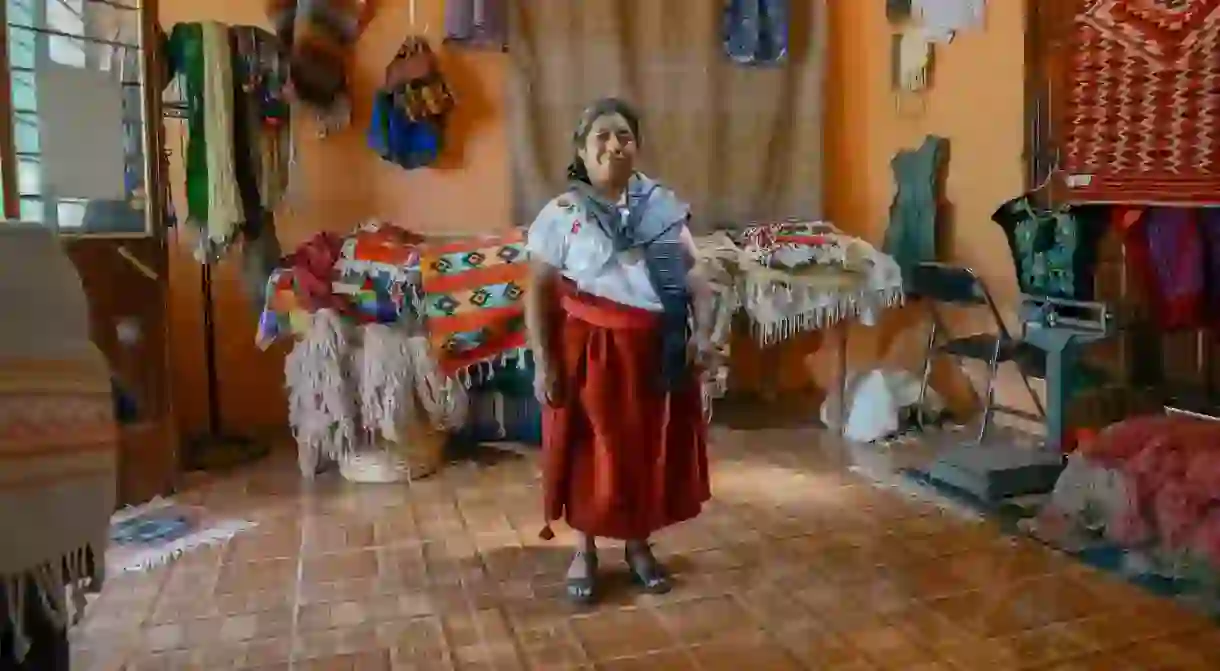What to Know About Cochineal Dyeing and How It's Used in Traditional Weaving

The traditional weaving of Oaxaca’s Zapoteca people dates back thousands of years to when this indigenous Mexican tribe was developing agriculture in the Valley of Oaxaca. The original inhabitants of this area cultivated an intimate knowledge of its plants and animals and traditional weaving became an important local craft and a means of trade with other towns and regions.


Part of that agricultural knowledge included the discovery of cochineal dye – an element that would take on great importance in their weaving. Cochineal are insects that feed off the local prickly pear cactus. If you have ever been to a market in Mexico you have no doubt seen their bright green paddle branches and ruby red fruit for sale.
The cochineal produce a carminic acid that acts as a deterrent to other animals or insects that might prey on them. Their dried bodies and eggs can be crushed to release this blood-red dye and used to color local fibers like wool or wild cotton.




At Dixza Rugs and Organic Farm, Samuel Bautista Lazo and his mother carry on the centuries-long tradition of Zapoteco weaving.
“At Dixza rugs and organic farm we still weave and farm like my grandparents used to,” says Samuel, “My mom’s side of the family were also butchers. Work in the slaughtering house started early and when the selling was over at the market, everyone would retreat to their looms and start weaving rugs the rest of the day. My dad’s side of the family were farmers and have a herd of cattle, they would combine weaving with farming. After the milpa (cultivated land with corn, beans and squash) was planted there is a period of waiting so they would retreat to weaving and producing rugs. Weaving is a craft that compliments perfectly any activity.”


Samuel’s mother is also still grinding, mixing and dyeing with cochineal as one of the natural dyes used in their intricately patterned rugs. The symbols and imagery woven into these rugs also have a long history behind them.



“It seems like scholars and curators don’t consider our weavings art. For a long time our weavings were considered only a craft. However, if they are understood from a historical perspective, it becomes evident that the weaving tradition is the continuation of an ancient art.”
“The elders would pass down the ancient patterns and symbols while the young people experiment with new techniques and materials.”
“Some master weavers have been recognized as folk artists presenting rugs that have very intricate traditional patterns and symbols or weaving innovative designs inspired in more recognized classical art or contemporary art, even prehispanic art.”



Samuel learned to weave before he could even ride a bike. He and his brother were taught this artform using the bottom of a chair as their first loom. He continues to work with traditional patterns and symbols but also incorporates his own designs from what he draws and sees in the world around him.
The Dixza rug workshop and farm sells their masterpieces worldwide but on a selective basis. They work to broker deals that are more than simply “fair trade” but provide a truly good wage for their weavers. Samuel travels the world to spread the rug weaving gospel to the masses.



“Our weaving allows us to communicate in the realm of images, patterns and symbols. I believe that our ancestors created these symbols and patterns to encrypt a deep understanding of the world as they saw it. I want to express my current understanding of the world so that one day my grandkids will remember our teachings and not make the same mistakes.”
He says that he hopes the weavings will bring some light to the issues of Mexican indigenous communities, like the discrimination they face and the dangers of climate change on their lives. He hopes to empower people to once again respect the art of weaving.


“Just like learning how to grow your own food you should learn how to weave to clothe yourself, weaving is empowering and gives you a tremendous sense of satisfaction after you take raw materials that you can gather from the environment and turn them into a beautiful piece of art that can be used and can speak to multiple generations.”













